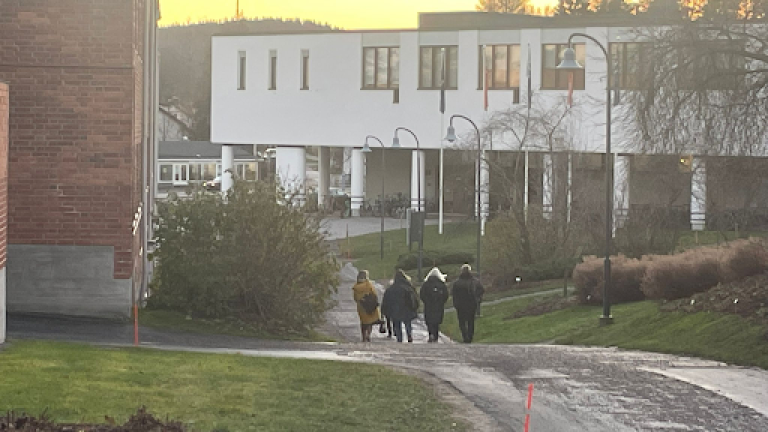LED Nordic experts met at the University of Jyväskylä to explore what is important in the learning environment design and research

A multidisciplinary team of learning environment design (LED) experts representing universities, municipalities and companies met in Jyväskylä in November 2024 to discuss what is important in the learning environment design and research. The meeting was part of the Nordplus Horizontal 2024 funded project Impact of Learning Environment Design on Teaching, Learning, and Wellbeing: A Nordic Perspective ("LED Nordic"). The project is coordinated by the Innovative Learning Environments research group at the Finnish Institute for Educational Research, University of Jyväskylä. It includes partners and collaborators from all nordic countries. In the meeting, researchers representing University of Jyväskylä, University of Oslo, University of Iceland and Royal Danish Academy were particularly interested in hearing what the representatives of the city of Helsinki, Reykjavik and Gladsaxe as well as the Finnish (Oppimaisema, Tmi Raija Kattilakoski), Swedish (Ecophon) and Norwegian (Norconsult Norge AS) company representatives thought is important in the learning environment design.
LED Nordic project draws insights from the emergent and multidisciplinary learning environment research, where Nordic countries have already made several significant research contributions. It builds on these contributions and previous collaborations, with the overall aim to explore, consolidate, develop and share new knowledge of the impacts of LED at various educational levels in the Nordic region. The project will facilitate a multi-professional Nordic collaboration on the development of new knowledge and innovative methods that are relevant for researchers, education providers (municipalities and educational institutions) and for pedagogical, industrial and architectural designers and consultants.
- From a research perspective, the primary objective is to create a multidisciplinary knowledge base of Nordic LED research (a) findings and (b) methods that can provide a basis for international comparative research. A second objective is to pilot innovative research instruments to evaluate their functionality across Nordic countries.
- For participants from other sectors, these objectives will support the application of research-based knowledge and methods in LED. Practitioners will also provide feedback on the practical value of research-based knowledge and methods.
The methodological approaches in the project include review work, seminars, and case studies. School visits are also organised as a part of the onsite meetings taking place in all Nordic countries. Outcomes include an open access summary of Nordic research findings and methods that will have practical, cross-sectoral value.
LED Nordic also entails collaboration with an international cross-sectoral Innovative Learning Environments and Student Experience (ILESE) study led by the Australian Learning Environments Applied Research Network LEaRN, whose representatives were present in the Hybrid seminar on learning environment design organised at the University of Jyväskylä in May 2024. The seminar served as a kick off for the LED Nordic project.
Lectures on the learning environment design given by the LED Nordic partners and collaborators are published as a part of the Multidisciplinary perspectives on Learning Environment Design ("MultiLED") project. The lectures serve as an open online course materials for students and practitioners in education and architecture (school design). These are the lectures published so far by our LED Nordic experts:
- MultiLED Lecture Series 1 | Sari Lehtonen (City of Helsinki): Evolution of Educational Building Typologies in Finland
- MultiLED Lecture Series 4 | Tiina Mäkelä (the JYU): Framework for Co-Designing Learning Environments
- MultiLED Lecture Series 9 | Tiina Mäkelä (the JYU): Hybrid Seminar on Learning Environment Design, 30th May 24
- MultiLED Lecture Series 10 | Tiina Mäkelä (the JYU): Teachers’ perceptions of learning environments
- MultiLED Lecture Series 17 | Siv Stavem (Norconsult Norge AS): The Emergence of Learning Spaces
- MultiLED Lecture Series 22 | Tmi Raija Kattilakoski: Inclusive design of school buildings
- MultiLED Lecture Series 23 | Collin Campbell & Pauli Pallaskorpi (Ecophon) Acoustics in innovative learning environments
- MultiLED Lecture Series 24 | Markku Lang (Oppimaisema):Timelapse methodology in Post Occupancy Evaluation
- MultiLED Lecture Series 25 | Julia Morris (Edith Cowan University): Is there a common research agenda for LE?
- MultiLED Lecture Series 26 | Wesley Imms (U. of Melbourne): Where is the evidence?

Project meeting also entailed a campus walk (Image ©LEDNordic project)
A news about the project in Finnish, see https://www.oph.fi/fi/uutiset/2024/pohjoismainen-koulutusyhteistyo-hyvinvointia-ja-kestavia-elamantapoja-rakentamassa
Further information: Tiina Mäkelä (tiina.m.makela@jyu.fi)
LED Nordic coordinator:
- University of Jyväskylä, Finnish Institute for Educational Research, University of Jyväkylä, Post doc Tiina Mäkelä (FI)
Partner institutions:
- Oppimaisema, Pedagogical expert Markku Lang (FI)
- City of Helsinki, Educational division, Architect Sari Lehtonen (FI)
- Tmi Raija Kattilakoski, Pedagogical expert Dr. Raija Kattilakoski (FI)
- University of Iceland, School of Education, Assistant Professor Torfi Hjartarson (IS)
- City of Reykjavik, Department of Education and Youth, Building & Equipment Maintenance Project Managers Thordis Eik Fridthjofsdottir and Daníel Benediktsson (IS)
- The Royal Danish Academy - Architecture, Design, Conservation, Assistant professor Bodil Hovaldt Bøjer (DK)
- University of Oslo, Department of Education, Professor Palmyre Pierroux (NO)
- Norconsult Norge AS, Educational planner Siv Marit Stavem (NO)
- Ecophon, Acoustic concept developers Colin Campbell, Ida Sederlund (SE) and Pauli Pallaskorpi (FI)
Collaborators
- University of Aarhus, the Danish School of Education, Associate Professor Lisa Rosen Rasmussen (DK)
- Municipality of Gladsaxe, Learning Spaces Design Services in the Education Division, School developer Kirsten Haase (DK)
- University of Melbourne Graduate School of Education, Associate Professor Wesley Imms (Australia)
- Edith Cowan University, School of Education, Associate Professor Julia Morris (Australia)



